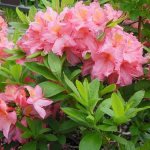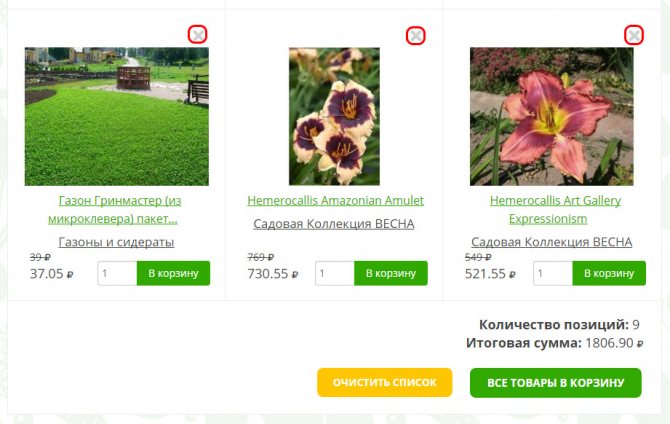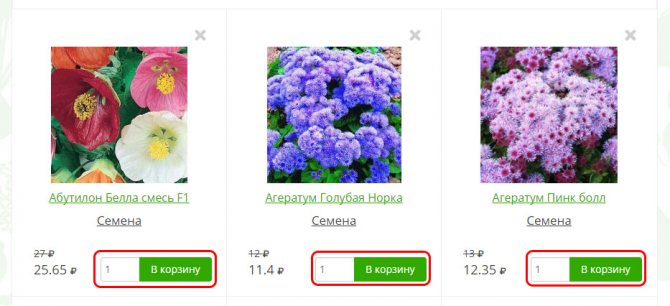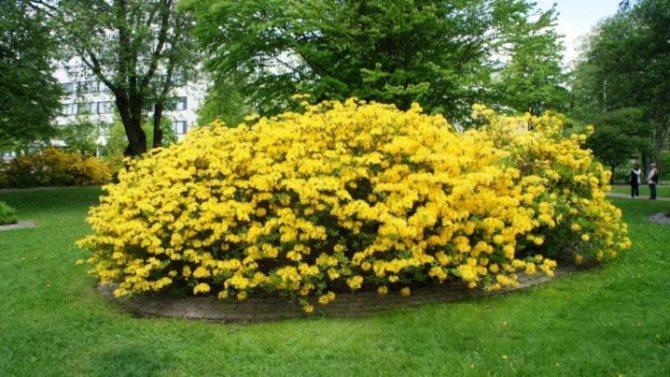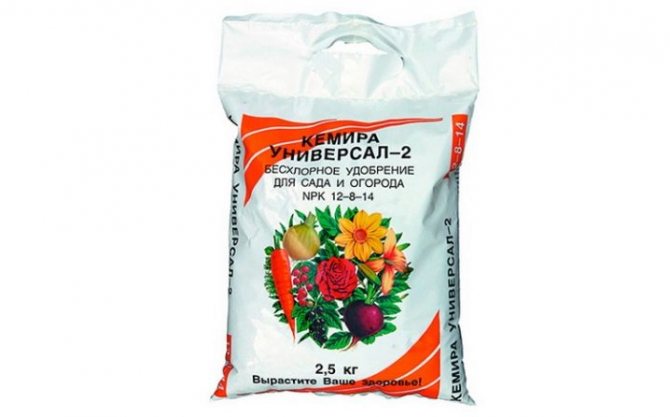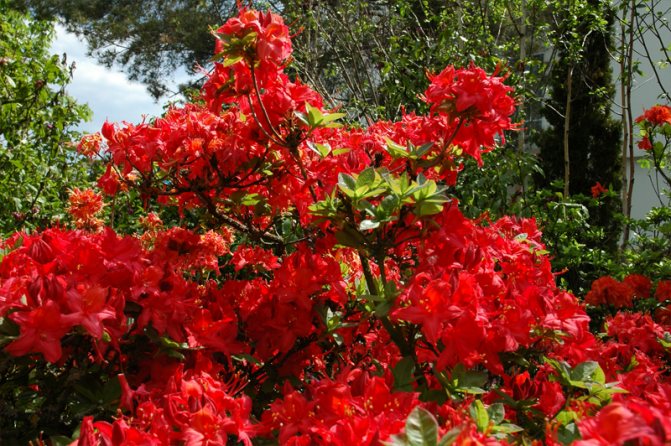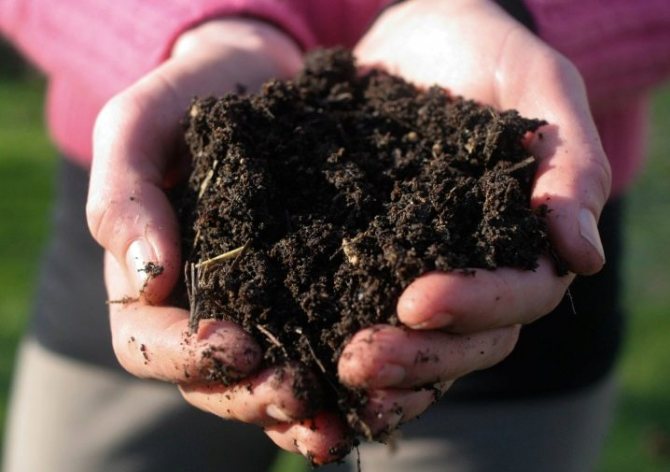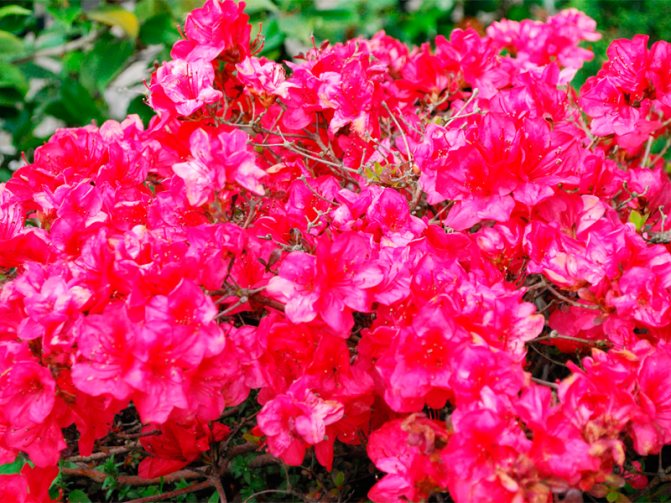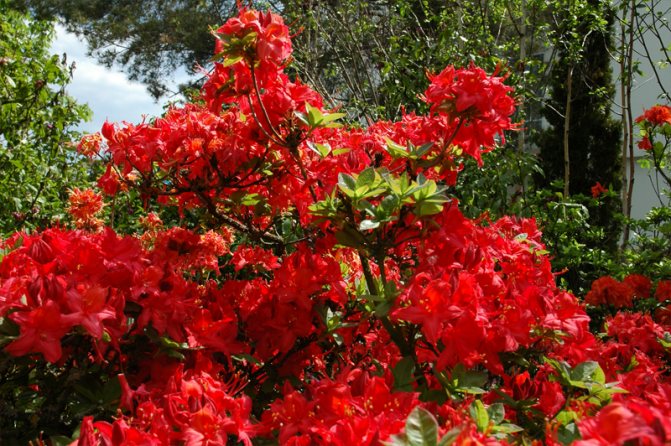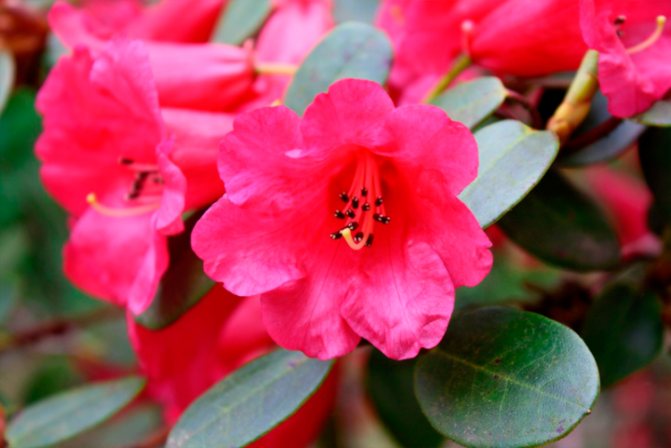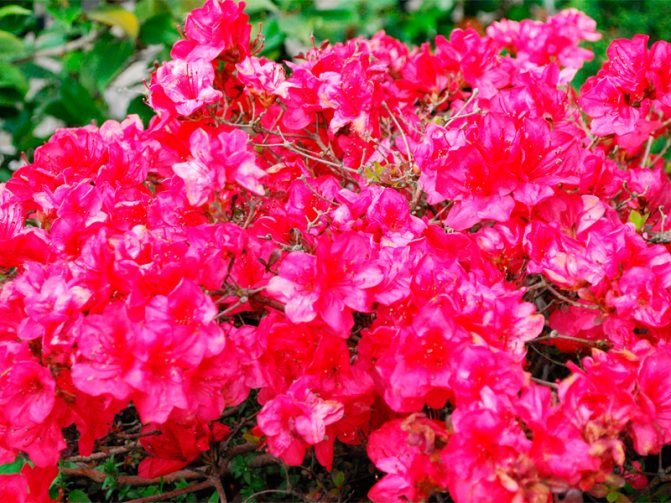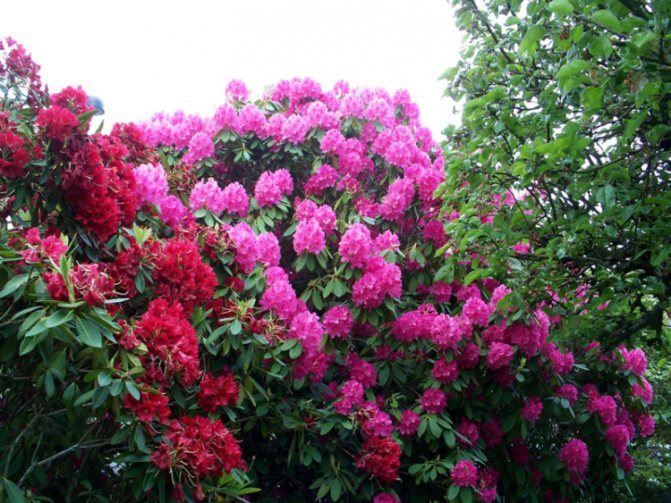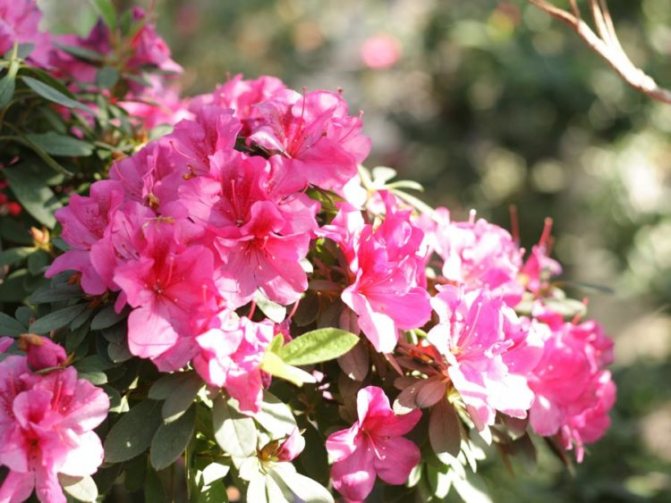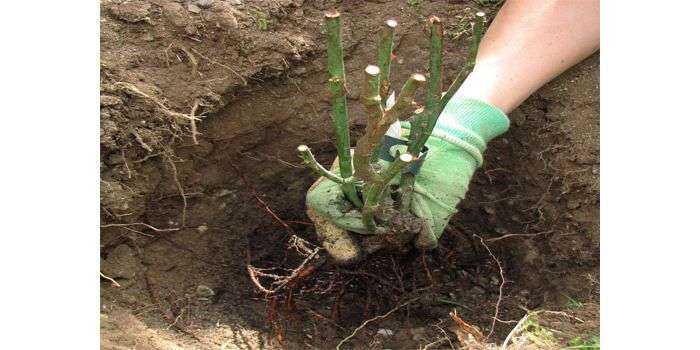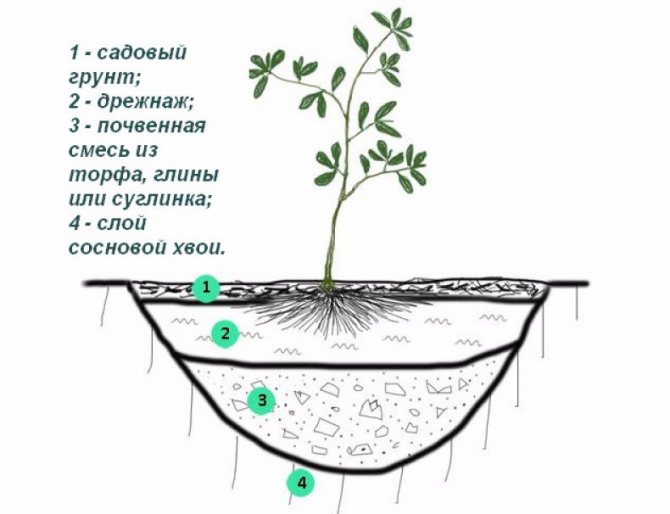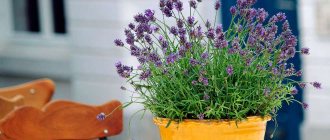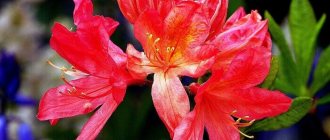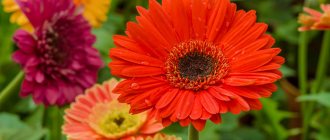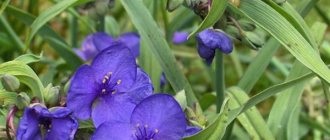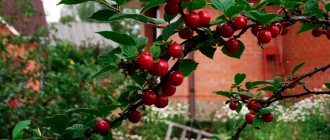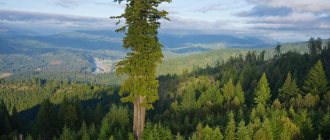Azalea is a shrub with amazing flowers from the Heather family. There are many varieties of this plant. Some bushes are grown only indoors, other varieties are perfectly cultivated in the open field, as they calmly tolerate frosts up to 25 degrees. A gardener who decided to settle an overseas guest on his plot should know the intricacies of its cultivation. Azalea garden, planting and care in the open field which is done correctly, will delight you with exquisite flowering and rich greenery.
How to plant an azalea
How to choose azalea seedlings
There are several types of azaleas. When buying, you need to consider this. And get all the information about the group to which this plant belongs, and find out its characteristics. Different species can behave differently and require different approaches to their care.
Soil requirement
For azaleas, acidic soil is ideal. It should not be dry, otherwise the flowers will not form well, and will also dry quickly. If the soil turns out to be like this, you need to provide good moisture. With a lack of elements, the soil must be well nourished with special means. To feed the plant, it is worth using humus, peat, moss, shavings.
Azalea planting scheme
Planting azalea seedlings from containers occurs in spring or summer. The planting depth is 50 cm, the width of the pit is 70 cm. Or you can calculate the depth based on the size of the root with an earthen lump, plus 15 centimeters. Drainage is needed in the pit. For these purposes, the use of broken brick and sand is the best option. Only you can't take crushed limestone.
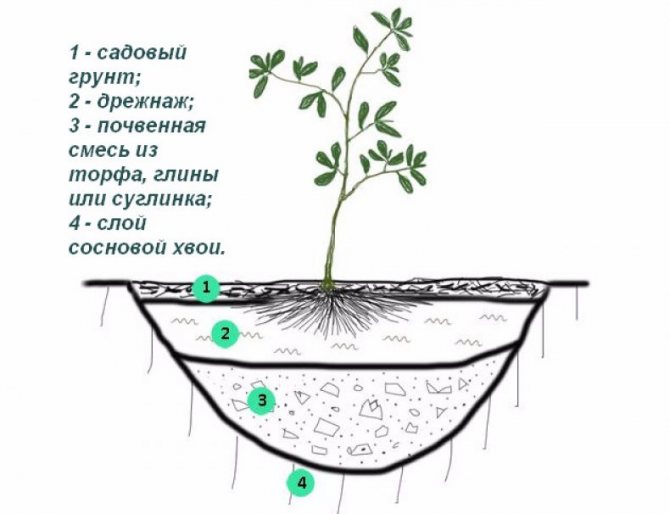
The height of the drainage layer should be up to 20 cm. The deeper the hole - the thicker the drainage layer. The next layer is peat and soil. The seedling itself must be planted along with a lump of earth in which it grew. You can't shake off the ground. The root collar of the azalea should not be covered with soil.
Next, we turn to the direct planting of the seedling and its watering. Mulching around the plant is also necessary. For these purposes, you need to use needles, moss, peat, chopped bark or leaves. This will make it possible to retain moisture, which is so necessary for azaleas, as well as protect the roots of the plant from pests and sunlight. This procedure must be carried out regularly.
What is required for a successful landing?
If there are conifers, then you do not have to decide on a place for planting azaleas. In the shade of their branches in diffused light, caring for the bushes will be easier. Under the bright sun, the Japanese guest begins to ache - the leaves wrinkle, shoots cease to form. Garden azalea does not like strong gusts of wind and sudden changes in temperature. Growing and caring for seedlings in the open field begins in late spring. The holes should be made shallow (about 45 cm), but wide.
Advice! In order for the plant to bloom well, experts recommend laying a layer of drainage under the flower bed. The top layer of the soil is removed, and broken brick is poured onto the bottom. The main thing is that it does not have the ability to leach the soil.


High-quality plant care is possible only when it grows in soil with a PH value below 4.7. Planting requires acidification of the earth with a food acid solution (a pinch in a bucket of water).For lush flowering of azaleas in spring, organic fertilizers are applied to the soil. Finishing planting in the open field, mulch the flower bed with the following materials:
- needles or bark of conifers;
- peat;
- oak leaves;
- chopped straw.
Mulching is necessary to preserve moisture in the soil, to protect it from possible frost. Despite the fact that caring for an azalea requires abundant watering, the place for the flower bed should not be swampy. Root decay cannot be avoided. The final stage of planting in the garden will be watering the land with settled tap water.
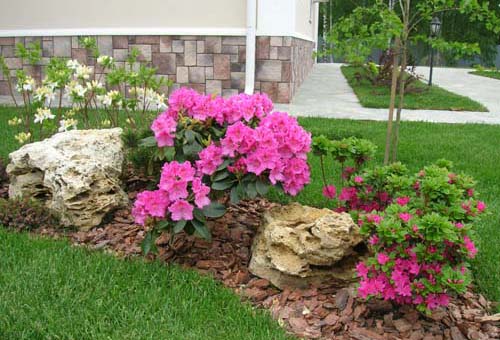

Garden azalea: how to properly care for a flower
How to properly water an azalea in the garden
Features of plant feeding
You need to feed the azalea shrub exactly three weeks after it has been planted. Then repeat the procedure should be repeated regularly every three weeks. For good growth and flowering of the plant, you need to use acidic water, which you water the azalea every month.
Soil care
Soil quality is an important prerequisite for the growth and flowering of azaleas. The best option would be acidic soil. If the soil has settled over time, then you need to add it and additionally mulch. Ash must not be added to the soil, and fertilizers containing chlorine and lime must not be used. Weeding can be done around the bush. But for this you should not use a hoe, since the root system of the plant is superficial, and you can damage it. But it is worth removing the weeds.
Rules for pruning azaleas in the garden
What do you need to know about grooming?
So that the Japanese azalea does not get sick, it is necessary to take proper care of it. The root system of the plant is almost on the surface of the soil, so watering at the root will not work. Moisture should spread throughout the entire area. Water should be watered in the morning or evening after sunset.
Advice! Garden azalea responds well to spraying. You can arrange a shower for her every day. An exception is the flowering period - flowers can become covered with ugly brown spots.


Japanese azalea does not need constant feeding. In the spring, it is worth fertilizing the soil with a strong infusion of mullein. After the end of flowering, caring for the shrub requires helping the weakened plant by introducing complex fertilizers. It is important that it does not contain chlorine.
- Remove dried flowers permanently. This will serve as an excellent stimulation for the formation of new buds.
- Cut dry branches with pruning shears, which will facilitate the establishment of new shoots.
- Acidify the soil regularly.
- Identify the presence of pests.
Advice! If the plant has stopped blooming, and the leaves have lost their turgor, then it is painful. From spider mites and thrips, insecticide treatment will help. When discolored areas appear on the leaves, it is worth acidifying the soil. Brown spots on buds and leaves indicate the development of putrefactive processes. In such cases, spraying and watering the soil with fungicides (Fundazol, Oksikhom) will serve as salvation.


Caring for Japanese garden azalea involves autumn pruning. Long shoots are removed by a third, dried branches are cut out. Gardeners lay the shape of the bush, act according to the rule - the more you cut off, the more it will grow in spring. The earth on the flowerbed is poured, and laid on top:
With the help of a wire frame, the azalea branches are bent to the ground and also covered. The cover material must be breathable. If the winter has turned out with a small amount of snowfall, then you should build a snowdrift yourself. In the spring, the material is removed after establishing a positive temperature.
Despite the fact that Japanese azalea grows slowly, it rapidly acquires new shoots. The bush increases in volume, begins to bloom and from a distance resembles a bright ball. If the care of the plant in the open field was correct, then in a couple of years many balls will be scattered around the garden. What else does a florist need?
Experts do not consider azalea to be a capricious shrub. It takes root easily, loves water procedures and requires a transplant every three years. In addition, it is a perennial, that is, planting does not require autumn digging. And it will not be difficult for such a beauty to acidify the soil.
How to keep an azalea in winter
Other species can withstand severe frosts up to 30 degrees. It is also possible to cover the plant with polyethylene. In this case, it must be borne in mind that winter can be quite humid. Then, in the shelter, the possibility of moisture removal is provided. If this rule is not followed, the azalea can rot or get sick. The plant leaves the winter state after the snow has melted. In early spring, after the plant wakes up, the sun can burn the stem, this must also be taken into account.
Azalea, photo
Azalea in the garden: planting and care
Garden azalea or rhododendron (modern classification) is a perennial shrub that will decorate any garden. This plant is characterized by abundant flowering, during which the branches literally drown in the buds.
If you decide to plant an azalea on your garden plot, it will take a lot of effort. Growing exotic bushes is a rather difficult and time-consuming process, but with due diligence and further care, it will certainly be successful.
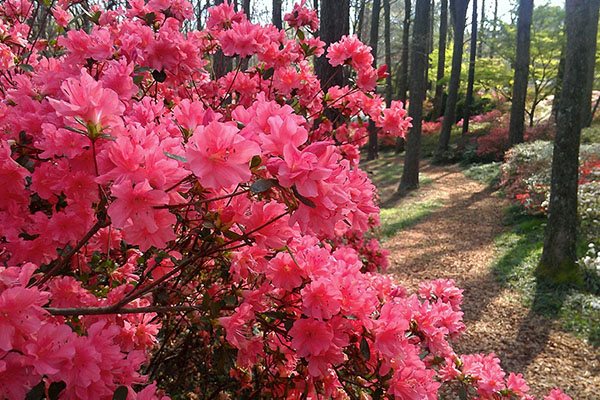

The use of azaleas in garden design
- Garden azalea is a wonderful decorative "material" in the hands of not only professional landscape designers, but also ordinary amateur flower growers. After all, an ordinary perennial bush planted will become a real decoration of any garden or personal plot.
- Azalea looks spectacular both in a single planting, as a bright accent, and in picturesque group plantings.
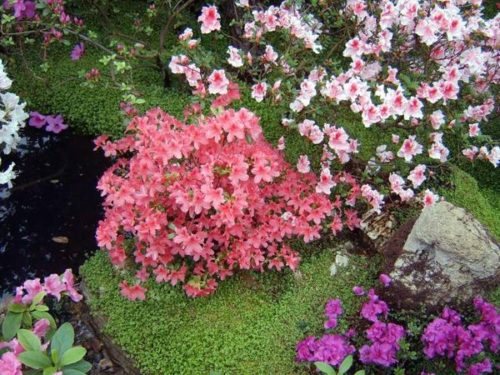

- Garden azaleas look good against the background of any coniferous crops, as well as in a company with camellia, heather, barberry, hydrangea and weigela.
- Group plantings of azaleas of different colors will look picturesque. In this case, tall shrubs should be located in the center, and undersized around the perimeter. It is not recommended to mix deciduous and evergreen varieties in one group, since in spring and autumn the decorativeness of the plantings will be greatly affected.
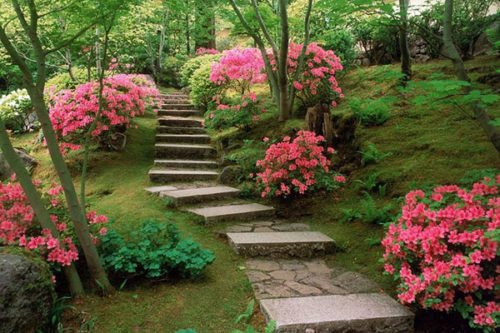

Thus, the garden azalea, without exaggeration, is a real favorite among the many decorative perennials. While enjoying the beauty and splendor of its flowering shrubs, it is important to remember the exactingness of this garden culture to the cultivation conditions. Only by observing all the rules of agricultural technology and caring for a perennial can you grow a "miracle shrub" on your site.
Types of garden azaleas
Azalea has long ceased to be a thermophilic greenhouse plant. Thanks to many years of hybridization, bushes were obtained that can withstand harsh winters when the air temperature drops to -30 degrees.
Thanks to the use of the Japanese azalea as a parent, the breeders received flowers that are ideal for central Russia, and with proper agricultural technology, they please with long budding from 3 to 10 weeks.
There are over 350 species of garden azaleas that are successfully grown in a wide variety of conditions. All of them can be roughly divided into two large groups:
- Deciduous. They are compact or tall bushes with small foliage, covered with burgundy or brown hairs. The flowers are funnel-shaped and appear in the spring, dropping after about 3 weeks. The deciduous mass retains its decorative appearance all summer, and in autumn it turns red;
- Evergreen perennials. The bushes of these types of azaleas are spreading and low, tolerate frost well and can even be grown indoors in winter after transplanting into a pot.
Read also: How to plant and care for a creeping tenacious
The colors of the azalea buds are striking in their diversity - among them there are white-flowered, yellow-flowered, and even purple-colored specimens. The use of bright bushes in the landscape design of the infield will help create harmonious compositions with other plants, where the main role will be given to the rhododendron.
Varieties and types of azaleas for open ground
Azalea has been known to breeders for a long time, therefore, at present, this type of plant has many varieties and varieties that differ in appearance, shrub height, flowering time. Most of the varieties bred have increased frost resistance and grow well even in regions of risky farming.
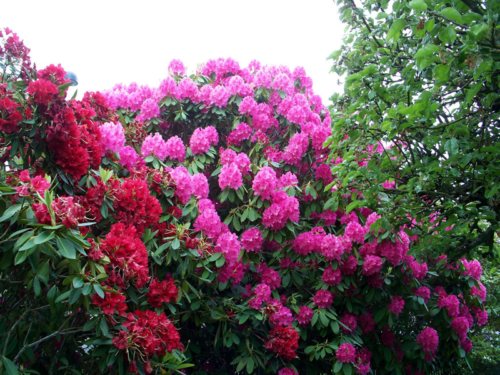

In botany, all garden azaleas are divided into 2 groups:
- Deciduous, i.e. those that shed their foliage in the fall.
- Evergreen, retaining foliage (or most of it) throughout the year.
The most popular among gardeners are large-flowered (deciduous) and Japanese garden azaleas.
- Large-flowered azaleas are represented by tall, spreading shrubs with large flowers of various colors and shapes. The flowering of this group of azaleas begins in late spring and lasts until June. The most common winter-hardy varieties are: "Freya", "Tunisia", "Chanel", "Starus", "Sonya", "Klondike", "Golden Sunset", "Golden Lights". Special attention should be paid to the late-flowering variety of large-flowered azalea with beautiful bright orange flowers, called "Gibraltar".
- Japanese azaleas They are distinguished by slower growth rates, a long (up to 2-2.5 months) flowering period and a neat, compact bush shape. Azaleas of this group grow no more than 100 cm in height. Dwarf forms are also cultivated, reaching a height of only 30 cm. Due to their short stature, compactness and splendor, clumps of Japanese azaleas are often used as a spectacular ground cover plant. The colors of the Japanese azalea varieties are also varied, ranging from subtle purple to deep purple. The most popular Japanese garden azaleas are the following varieties: Kermezina, Silvester, George Aredes, Blue Danube, Rosinetta, Marushka, Rubinstern, Petticoat, Ledikanense. Variety "Petticoat" grows no higher than 50 cm and blooms in late autumn, with delicate pink flowers. But azalea "Ledikanense" blooms on the contrary, early (in spring), abundantly covering the bush with inflorescences of a purple hue. Azalea white "Adonis" is distinguished by snow-white inflorescences and glossy, olive-colored leaves.
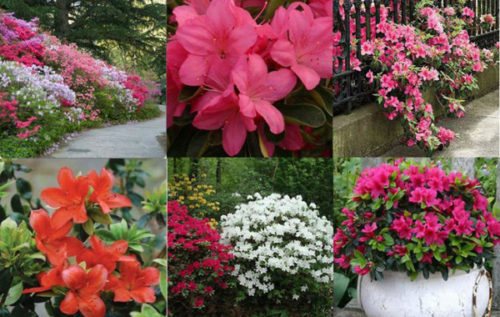

Where to buy azalea for outdoor use?
The azalea flower is a fairly common plant grown in the garden. Therefore, it is not difficult to buy perennial seedlings. This can be done at any specialty store or nursery. It is better if the selected azalea specimen is zoned, i.e. adapted to local climatic conditions.
- Shrub seedlings should be bought in the spring, just before planting them in open ground. The best age for planting young seedlings is 2-4 years.
- The best option is to buy azalea seedlings with a closed root system, in wide pots with fertile soil. According to the reviews of azalea gardeners, a seedling transplanted from a pot easily and quickly takes root in a new place.
- Outwardly, a young azalea seedling should look healthy, without damage and dry shoots. The soil in the container must be kept moist. And in the case of buying seedlings with an open root system, the roots should also be moistened with a lump of earth.
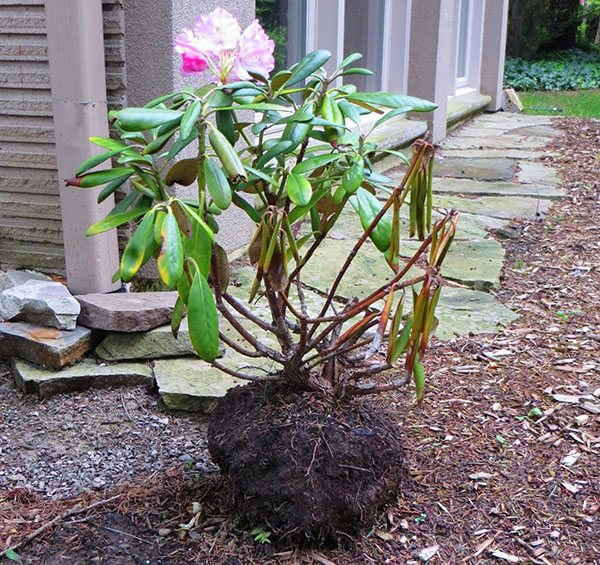

Pick-up location


Azalea, although a light-loving plant, does not tolerate prolonged exposure to direct sunlight, which worsen the decorative characteristics of the bushes, reduce the duration of flowering and prevent the buds from forming normally.Not suitable as a site and a place in dense shade, where the bush will greatly slow down in development or even wither away.
It is not recommended to plant azaleas at the corner of a building or between buildings where there are constant drafts. Exposure to winds will negatively affect the condition of the bush, especially during a cold winter, and can completely destroy the plant.
It is optimal to plant an azalea from the north, east or west side of the house in an area where there is no long stagnation of water, drafts and changes in soil height. The plant will benefit from being close to a natural or artificial reservoir - natural humidification of the air will contribute to long-term flowering and help keep the foliage fresh.
Azaleas will benefit from the neighborhood of large trees, which in the hot season will protect it from drought and the scorching sun, forming partial shade. It is optimal to grow a bush next to an oak or heart-shaped lime tree, as well as species with a tap root system. It is better to plant the rhododendron at a short distance so that the root systems of the plants do not interfere with each other.
Characteristics of varieties
The name of the shrub has Greek roots. So, rhododendron (Rhododendron) literally means "rosewood". However, the flowering bush does not belong to the Rosaceae family, its relative is the heather family. Among Russian flower growers, another name appears - azalea, however, from the point of view of botany, this is not entirely true.
Other types of flower fall into the category of yellow (lutea) varieties - for example, Sylphides, Homebush. They differ in the color of the blossoming buds, as well as the size and shape of the flowers. A common trait that unites them all is lush green foliage.


According to the description, the yellow variety rhododendron is a tall (up to 4 meters) lush shrub with spreading branches. The leaves are oblong, ovoid, slightly pointed towards the end. The width of the leaf varies from 2 to 8 cm, the length is from 4 to 12. If you look closely at the leaf, you will notice that its edges are framed by small denticles (cilia). The length of the petioles reaches 7 centimeters.
The flowering period is accompanied by the blooming of yellow / orange flowers on the bush, differing in saturation. Their shape is elongated (up to 7 cm), 5 cm in diameter. One bush can contain up to 20 volumetric inflorescences. In the center of each bud are curved stamens (by the way, they are higher than the corolla). The flowering culture begins in April and lasts until June. This period is characterized by a strong aroma that fills the surrounding air. At the end, a large number of oblong fruit bolls are formed on the branches of these varieties.
Closer to autumn, the foliage turns yellow and falls off. From spring to autumn, the plant can grow by about 4 cm - in the most favorable conditions, the figure reaches 15 centimeters.
It is important what you need to know about the rhododendron - a poisonous flower. Eating by animals, as well as getting into the human stomach of its leaves, petals threatens with severe poisoning.
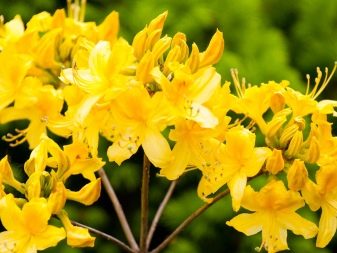

Selection of seedlings and preparation for planting
It is recommended to purchase seedlings in spring, when you can accurately assess the quality of the planting material:
It is necessary to plant azalea in open ground in early spring, before the active movement of juices along the trunk begins. Depending on the region, the landing is carried out at the end of March until mid-April, when the snow melted and a stable temperature regime was established. Also, garden work is carried out in September - for the remaining warm period, the plant will have time to take root in a new place and successfully acclimatize.
Attention should be paid to the composition of the soil, to which the azalea is very demanding. Lime substrates or loams are not suitable - the plant will die in them. It is optimal to add the following components to the site in equal amounts before planting:
- Sour turf;
- Coniferous land;
- Sand and peat.
To do this, at the selected place, the topsoil is removed to a depth of 50-60 and replaced with a prepared substrate.
Until the moment of planting, the root system of the bush azalea needs to be revitalized - for this, the earthen lump is lowered into the water or spilled abundantly. This will help the roots quickly get used to the new site and grow.
Growing a garden shrub
The plant can be propagated by labor-consuming seed, as well as vegetatively - by cuttings and layering (for details on how to reproduce azaleas at home, read here).
Seed propagation
The sowing substrate consists of equal amounts of peat and sand. In spring, small rhododendron seeds are scattered over its moist surface and covered with plastic wrap. The greenhouse is kept at 20 degrees, the substrate is ventilated and moistened. The germination time is usually 3-4 weeks.
When the first true leaves grow seedlings are planted more freely, while deepening them to the cotyledonsto stimulate root development.
After that, young plants are kept at a temperature of 8 to 12 degrees and a daylight hours from 16 to 18 hours, which is created by additional lighting. Water through the pallet.
By June, the seedlings are again planted less frequently and grown.
Winter temperatures should not rise above 18 degrees. In the spring, small rhododendrons are again planted at a distance of 3-4 cm from each other, but only in the third year will they be ready for planting in the ground.
Cuttings
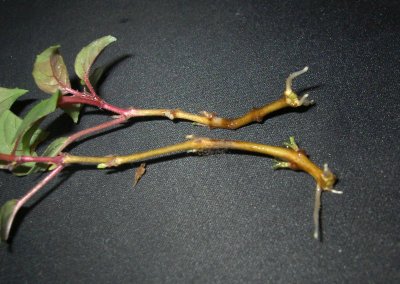

For this method of reproduction, semi-lignified shoots are used, from which 5-8 cm cuttings are cut. The lower sections are placed in a growth stimulant solution for 12-16 hours. Then they are planted in containers with a light soil mixture and covered with plastic wrap.
Ventilate, maintain humidity. Rooting takes a long time (up to 3 months) and is not always successful. Rooted cuttings are grown in a mixture of peat and pine needles; They hibernate indoors, at a temperature of about 10 degrees. In the spring, they are buried in the ground in planting boxes, and finally planted, at least another year later.
Layers
In the spring, the selected young branch is bent to the ground, fixed, added dropwise and watered, avoiding stagnant moisture (with what water and how should the azalea be watered?). When new resistant shoots appear, the layers are finally separated.
Planting an azalea: step by step instructions
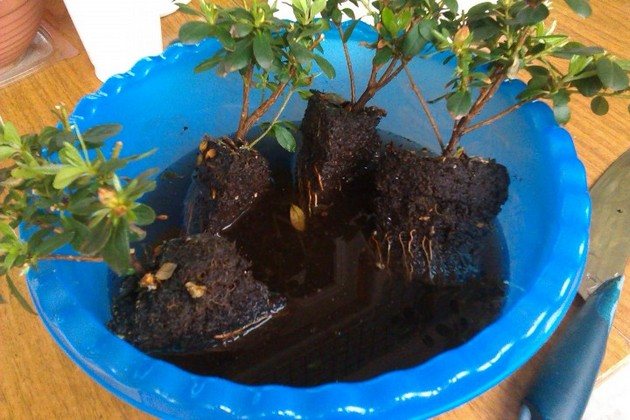

In order for the azalea to please with lush flowering, as in the photo, it is not enough to buy a healthy and high-quality seedling. The bush must also be planted correctly in compliance with all the necessary rules.
Since the root system of a rhododendron is shallow, it is not recommended to dig a hole too deep when planting. Looseness and air permeability of the soil are prerequisites for the normal growth of this shrub.
The azalea planting scheme is simple:
Description of the plant
Azalea grows as a bush. More recently, it was isolated as a separate genus of rhododendrons, but at present, many reference books classify the plant as heather. In nature, there are varieties of deciduous and evergreen forms, the care of which is radically different.
If the care of the azalea in the garden is carried out in accordance with the recommendations, then the bush can grow up to 3 meters. There are also miniature varieties, the height of which does not exceed 35 cm. Azalea blooms in white, pink, orange, purple and yellow tones. The flowering period lasts from 10 to 60 days. At the moment of blooming, the bush is completely covered with flowers, through which delicate greenery is barely noticeable.
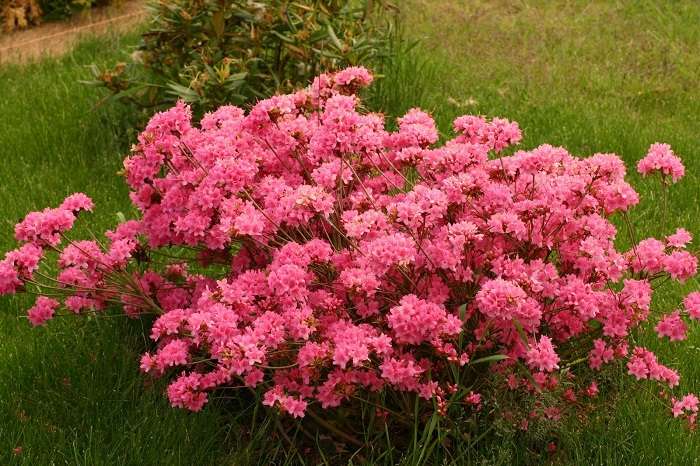

Rhododendron looks very impressive in garden plots, but favorable conditions should be created for flowering with chic caps. I bought it and planted it - it won't work with an azalea. The guest is demanding on the conditions of detention, the place of cultivation, soil moisture and shelter for the winter.
Azalea garden care
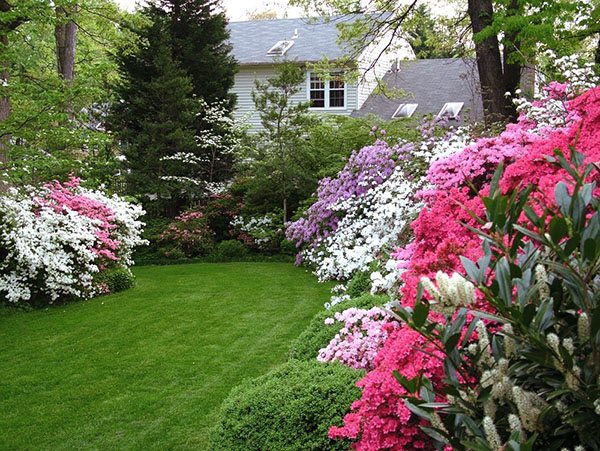

It is only necessary to bond with the azalea if you can provide it with proper care after it is planted outdoors. Careful attention to the shrub guarantees super-abundant and long-lasting flowering, as well as a healthy appearance of the ground part and roots:
It is imperative to prune bushes from 3 years old. Until then, it is recommended to simply remove dead, dry and defective branches. The best time for pruning is spring. Shoots are shortened by 1/3 of the total length evenly throughout the plant to create a beautiful crown.
However, it is worth remembering that flower buds are laid on annual branches, so it is better not to touch them during pruning, providing simple sanitary care. You should also consider other nuances:
Although the Japanese varieties of bush azaleas growing in open ground tolerate winter well in central Russia, sometimes the flower buds that are located at the ends of the shoots still freeze slightly.
Covering a bush before the onset of cold weather will help prevent an unpleasant situation. Preparation begins with abundant watering until frost with further mulching (for low-growing ones, the mulch layer should be 5-10 cm, for tall specimens - about 30 cm).
After mulching, the shoots of the street azalea must be carefully bent to the soil and fixed with wire, then covered with a layer of cardboard. A layer of peat or spruce branches is placed on top of the cardboard. The use of airtight covering materials is not recommended as flower buds can rot or rot in such an environment.
Read also: When is the best time to plant tulips
Wintering and transplanting garden azalea
In the autumn, flower buds are laid at the plant. How the azalea blooms directly depends on the quality of wintering. The plant must be prepared for winter in the most careful way. In the fall, before freezing the soil, the shrub should be thoroughly watered.
In order for the plant to have time to prepare for winter, you should not carry out top dressing in the fall.
Cover the root zone for the winter a protective layer of peat, pine needles or foliage. A layer of 5-7 cm will be enough for young plants. For adult tall shrubs, a layer of insulation of 20-30 cm is required.
Transplanting the azalea is best in the spring. If you did not have time to do this, you can transplant the rhododendron immediately after flowering, but no later than September. Since flower buds are laid in the fall, active flowering cannot be expected the next year after transplantation.
A little about the form
Domestic growers may prefer two main types of garden azaleas - evergreen or deciduous. The key difference between them is the height of the bush. Some representatives reach a height of no more than 60 cm, while others grow up to 3 m. When choosing azalea varieties for cultivation and care, also pay attention to the flowering time of shrubs. They can be early, medium or late flowering.
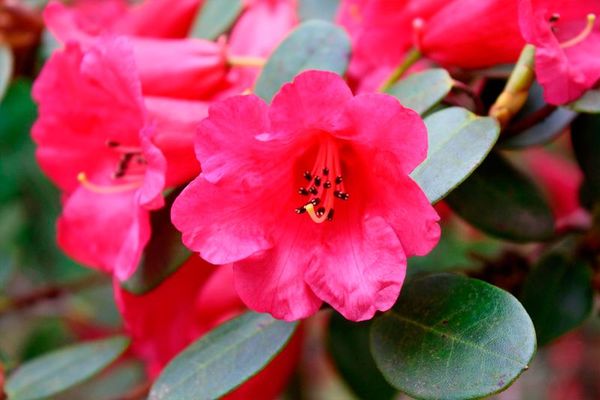

With proper care, you can make the flowering process almost continuous, and the shrub will be protected from disease. Remember: azalea grows rather slowly, so after planting it in open ground, you should be patient. Interestingly, there are about 10 thousand varieties of this plant in the world. In the last few years alone, 200 new varieties of rhododendron have been bred by breeders.
Garden azalea can take root in various climatic conditions. But in order for the shrub to develop intensively, without the invasion of pests or diseases, it is necessary to adhere to the basic rules regarding planting and care. Remember: the more attention you pay to your garden plant at the time of planting in open ground, the easier it will be for you to control the growth of the shrub in the future.
For example, if you decide to plant shoots in the ground, rather than seeds, it is recommended to take special care of the rhododendron root system, as it is very weak. In order for the cultivation of azaleas (including in the Moscow region) to bear the first fruits as soon as possible, plant the flower in several stages:


If the azalea planting is done correctly, soon the shrub will delight you with its flowering.
Azalea is an unpretentious shrub. And nevertheless, care for this plant must be provided thoroughly if you want to get a lush specimen, densely dotted with bright flowers. To care for such flowers in flower beds competently, you need to pay special attention to watering, forming a bush, as well as feeding and pruning.
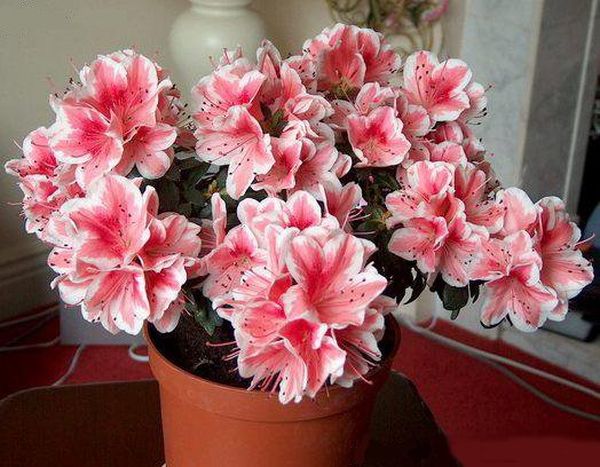

Watering mode
In order for the azalea in the garden to delight you with its flowering, you should not save on feeding the plant. However, it is recommended to observe some features of soil recharge. For example, fertilizers should be applied to the soil in small concentrations. Otherwise, salts will accumulate in the substrate, and this will adversely affect the condition of the shrub.
The appearance of the flower often testifies to the need for replenishment: if the leaves are faded and there are no ovaries on the bush, it's time to acquire a nutritional composition. Horn shavings or superphosphate are best for this bush plant.
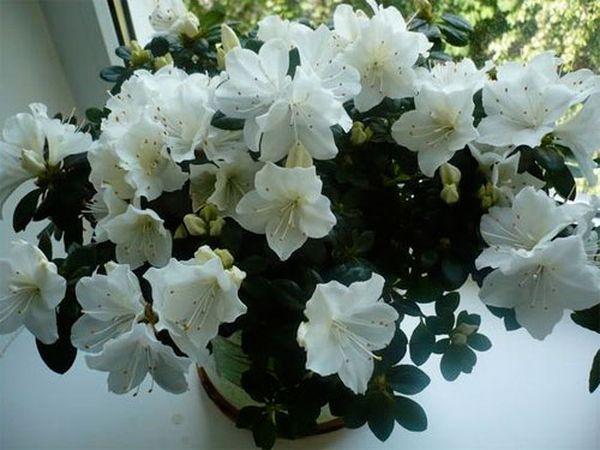

Remember: you can accelerate the growth rate of azaleas if you saturate the soil with magnesium sulfate or potassium every six months.
Trimming and shaping
To prevent diseases and pests from overtaking the street azalea, you need to take care of it carefully. Pruning the bush requires special attention. The formation should be started after the flowering of the treelike rhododendron. Remove old branches and peduncles. If pruning is neglected, the risk of disease and pests will only increase over time.
Preparing for winter
It is very important to properly prepare the azalea of the Japanese garden variety for wintering. The thing is that buds appear on the bush already in the autumn. If the rhododendron is not properly protected from the cold, it will not bloom with the onset of spring. What exactly is required of you is to thoroughly water the soil before freezing. It is better to refuse feeding. Cover the ground around the bush with a mixture of peat and foliage.
Diseases and pests
In a favorable environment, diseases do not affect the plant.


Fungal spot - a consequence of growing in caked waterlogged soil. To eliminate it, the moisture intake is optimized and the treatment is carried out with copper sulfate or Bordeaux liquid.
If there is not enough nitrogen and potassium, with stagnant moisture, a mixed chlorosis - leaves turn yellow with spots. In this case, eliminate excess moisture, provide drainage and spray the bush with a solution of ferrous sulfate: 7.5 g per liter of water.
Red spots along the veins on the leaves appear when there is a lack of soil nutrition. The situation will be corrected by feeding with ammonium fertilizers or potash nitrate.
After severe frosts on an uncovered plant leaves die, therefore, you should not remove too early a winter shelter from foliage or spruce branches (how to cover a rhododendron and properly prepare for winter?).
In open ground conditions on the rhododendron such insect pests: rhododendron bug, spider mite, Asian garden beetle. Control measures - spraying with diazinon.
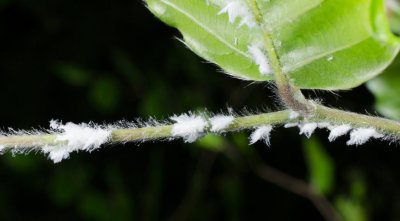

Mealybug. It is eliminated by spraying with karbofos.
Furrowed weevil. Malofos helps against it, as well as bazudin, diazinon and furadan.
Narrow-winged miner moth. In this case, the bushes are fumigated with sulfur.
In addition, garden azaleas can eat slugs and snails. Such "guests" are simply collected, and as a preventive measure, the bushes are treated with a fungicide.
Taking care of the "pink trees" (this is how the word "rhododendron" is translated from the Greek), maintaining the necessary acidity and moisture of the soil, feeding these perennial plants in time, you can admire their abundant flowering every summer, which becomes more and more magnificent over the years - as in the famous gardens Leonardsley.
We talked more about the most common azalea diseases here.
Reproduction


A blooming perennial will certainly become your favorite in the garden. Over time, the flower collection can be replenished if you master the propagation technology of azaleas. It is mainly used in two ways - using seeds or cuttings. The second method will bear fruit much faster. For this, the cut off shoots are placed in cups filled with well-moistened peat. It is better to cover the cuttings with foil on top.
Maintain a consistently high temperature (18–20 ° C).
Do not forget to open the airing film from time to time. Under such conditions, the roots of the stem processes will appear rather quickly. Create all the necessary conditions for the azalea, and it will not be afraid of diseases or pests.
Photo
See more photos of rhododendron in the garden:
Blooming azalea is a unique sight. The bush, completely covered with inflorescences of different shades, looks like a festive bouquet. How to provide home care after purchase, plant and transplant a plant - read on our Internet portal.
Azalea is a shade-loving beauty. Planting azaleas, growing and care
If you think that azaleas are exclusively indoor or greenhouse flowers, then you are deeply mistaken. It turns out that there are winter-hardy varieties of this beautiful plant that can easily withstand sub-zero temperatures down to –27 ° C. So that you can figure out which species of azaleas can be grown in your garden, we will try to tell you in detail about planting and caring for this magnificent bush.
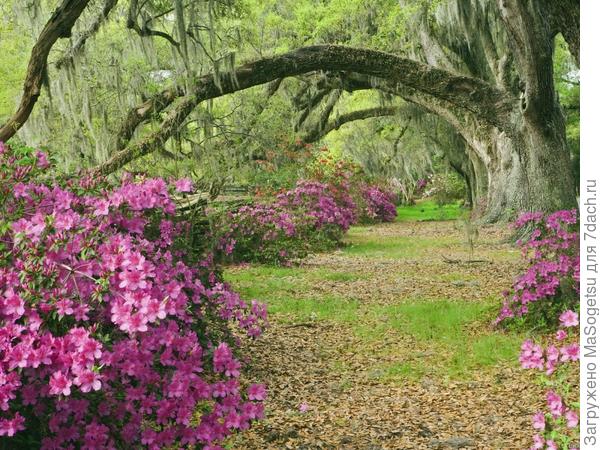

Planting azaleas
Azalea is a capricious and demanding plant. All growing conditions are important for him: light, temperature, soil composition. There should be as much light as possible, but the azalea does not tolerate direct sunlight - when they hit the plant, it weakens, the leaves wrinkle, and the buds fall off. Therefore, it is necessary to choose places with partial shade or diffused light. This applies to evergreen species of azaleas (for example, the Japanese azalea). Deciduous azaleas prefer a bright and at the same time protected place under the trees.
Read also: Miracle shovel "Mole": features and benefits of using garden tools
The next important factor when growing azaleas is the correct selection of soil cover. You can pick up the soil mixture yourself (you need a loose and acidic soil containing coniferous soil, sand and peat) or buy soil for azaleas in stores. The root system of azaleas is superficial, therefore, if necessary, it is enough to replace 40-50 cm of the upper fertile soil layer.
Azalea propagation
Azalea is propagated by seeds and cuttings. The last method is faster, so we will consider it.
Propagation of azaleas by cuttings
Azalea care
Caring for a garden azalea consists in timely pruning, proper watering, feeding and covering for the winter.
Pruning
Pruning is done after the plant has faded, about 2 weeks later. When pruning, remove wilted or strongly thickening shoots completely, cut off other shoots by about a third of their length. To keep the garden azalea bush lush and branch well the next year, we prune around the entire periphery of the bush. We cover the cut points with paint on linseed oil or garden varnish. To lay a larger number of flower buds, it is also advisable to remove completely wilted flowers from the bush.
Watering
Abundant watering and spraying garden azaleas love, because if you dry them out, you are unlikely to save them.But it is important not to pour them! For example, a plant needs abundant watering when it blooms. At the same time, at the time of flowering, the azalea does not need to be sprayed so that its beautiful flowers are not covered with spots. In autumn, when the air is humid, watering should be limited, and before the onset of winter, watering is necessary only in stable and dry weather.
Top dressing
Young seedlings of garden azalea are fed in spring with a mullein solution, and after flowering - with a phosphorus-potassium mixture of fertilizers (in a ratio of 1: 2). Adult bushes are fed in early spring with a mixture of long-acting complex fertilizers. Fertilizers when feeding are applied not under the root of the bush, but at a short distance from it (about 20 cm from the center of the bush). We draw your attention to the fact that garden azaleas, like other rhododendrons, are not suitable for fertilizer mixtures containing lime and chlorine.
Shelter for the winter
The garden azalea does not like the strong winter sun, which can easily destroy the roots of this plant. Therefore, any winter-hardy species of azaleas must be watered abundantly at the end of autumn until the ground is completely frozen. Then the evergreen varieties are covered with coniferous spruce branches, undersized varieties can also be mulched with oak leaves. We bend the branches of deciduous species as close to the ground as possible so that during the winter they would be under the snow.
Which breeding method should you choose?
An easy way is propagation by cuttings. Cut the cuttings about 8 cm at an oblique angle and remove the bud, as well as unblown leaves. A cut of the cuttings with a couple of leaves are treated with a growth stimulant, and planted in pots. Sufficient drainage holes must be made to prevent root decay. The pots are covered with foil and placed in a well-lit place at a temperature of 20-22 ° C.
Advice! The film should not come into contact with the seedling. Part of it will rot, which will spread over the entire surface. For this, one should not forget about daily airing for an hour.
Rooting will take place in one month. The first sign that the Japanese beauty has grown roots and that the seedlings were properly looked after is the formation of new leaves. A month later, the young azalea is ready for planting in flower beds. The soil can be composed of the following components:
- leafy land;
- coniferous earth;
- calcined sand;
- peat.
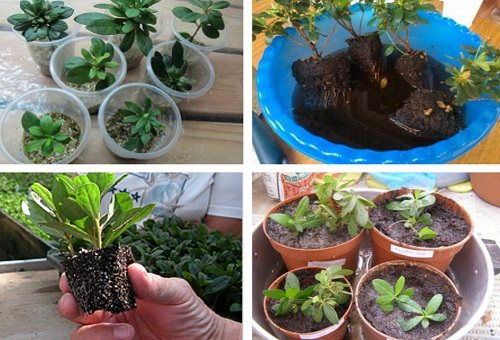

Growers don't often use seed growing. Even rooted cuttings of azalea bloom only in the 2-3rd year, and planting and waiting for adult plants from seed postpones this process for an even longer period. Some azalea lovers in the fall in the garden divide the bush into two parts. With a knife, they cut it in half and coat the cut off points with garden pitch. This method is not popular due to the formation required in the future.
Flower history
For the first time, the azalea flower became known to Europeans in the 17th century. They began to study, breed, cultivate the botanists of Belgium, Germany, France, England. They even competed with each other, developing new varieties. The first variety of a garden plant was bred in 1820. Active cultivation began at the beginning of the 20th century. Azalea turned out to be very finicky. For breeding, the creation of one variety took up to 10 years.


Azalea appearance
For your information! The plant is considered mythical, shrouded in secrets and legends. The ancient Greek scientist Xenophon once described the story of how Greek soldiers wandered along the roads of Colchis in search of the golden fleece. Once in the mountains they found a large apiary of honey. After eating they lost consciousness. It turned out that honey contained dangerous alkaloids, because it was made from the wild flowers of rhododendron, the ancestor of azalea.
Involvement in the genus Rhododendron
For a long time botanists had to study the relationship and similarity between rhododendron and azalea. They belong to the same Heather family. Azalea is essentially a subgenus of numerous species of rhododendrons.Rhododendron is translated as “rose tree”. This is a collective concept of individual species of azaleas.
At first, botanists ranked the plant as belonging to the Vereskovy family. Later - to the genus Rhododendron. To avoid confusion, amateur gardeners began to call the houseplant an azalea, and other gardeners - rhododendrons. Although they differ from each other in external characteristics. A garden rhododendron has 10 stamens, and a room azalea has no more than five.
Note! It looks like an azalea, its flowers look like a small dry shrub. Rhododendron looks like a flowering, branched, evergreen bush.
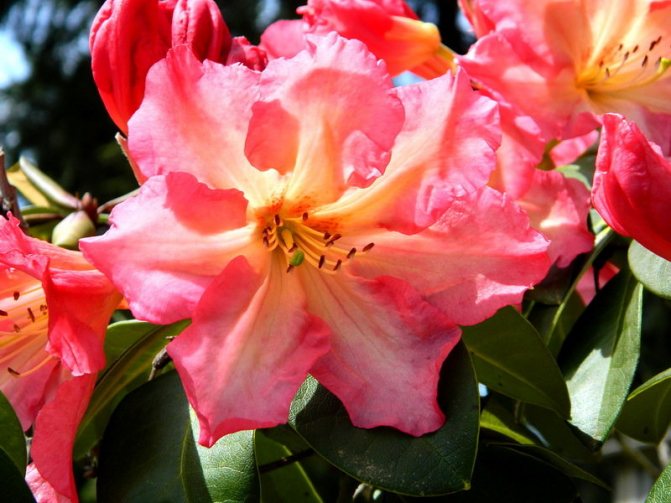

What does an azalea-rhododendron look like?
Bloom
When and how does this process take place?
Azalea Nap Hill blooms in late May - early June. Flowering is generous, long lasting, about 3 weeks.
Plant care
Azalea Nap Hill requires high humidity before and after flowering. Abundant watering is required. Immediately after flowering, dry inflorescences and leaves should be collected immediately. Young shoots must be pinched 2 times - in May and July. The pinching forms a lush crown.
What if there are no buds?
This variety will not bloom in the shade., it is necessary to transplant the bushes to a brighter place. In an alkaline substrate, Nap Hill azalea slows down growth and flowering, the composition of the soil should be changed.
Use in design
Azalea Nap Hill is used in combination with evergreen shrubs, coniferous plantations of juniper, pine, spruce. Coniferous trees create the right spotted shade for the flower, harmoniously combined with evergreen needles.
Varieties
Today there are many types of azaleas, each of which has certain characteristics.
Deciduous
Such plants lose their leaves in the fall, like the rest of the shrubs from the angiosperms department.
Japanese
There are many varieties in this category. These include Rocco, Bubushka, Allotria.
Multi-flowered
This type of azalea should include the varieties Alfred, Eskimo, Belcanto.
Evergreen Forest
This group includes crops such as Scarlett Wonder and Bad Elsen.
Yakushimanskaya
This is a dwarf variety category that includes Prince Anne, Blue Tit, Elite.


Soil and planting
Azalea will grow well only on loose and acidic soils, which contain sand, peat and coniferous soil. The acidity of the soil is necessary constantly maintain at the level of 4.0-4.5... For planting a seedling, early spring is suitable before the juice begins to move or the beginning of autumn - the bush will have time to take root in a new place before the cold weather begins and will normally endure the winter cold.
Garden azaleas have a shallow root system, so they don't need a deep planting hole. However, planting seedlings has some nuances:
- Dig a landing hole 0.5 m deep and 0.6-0.7 m in diameter.
- Lay a 15-20 cm drainage layer of sand, expanded clay and broken brick at the bottom of the pit - it will acidify the soil. It is undesirable to use limestone materials (crushed stone, crumbs), otherwise alkalization of the soil is inevitable, which azaleas do not tolerate.
- Mix the soil taken out of the pit with peat, humus and coarse sand to increase looseness and soil permeability.
- Pour the soil mixture onto the drainage layer and place the seedling on the hill, controlling the level of the root collar - after planting it should be slightly above the soil level.
- Gently fill the root ball with soil, compact the soil around the seedling, add soil and water if necessary.
- Mulch the soil around the bush with moss, peat, pine needles or crushed bark - mulch will prevent the growth of weeds and retain life-giving moisture in the soil.
Plants in containers can be planted throughout the summer, when removing from the container, the earth must not be crushed from the roots. Seedlings purchased from nurseries or garden centers should be watered abundantly before planting.
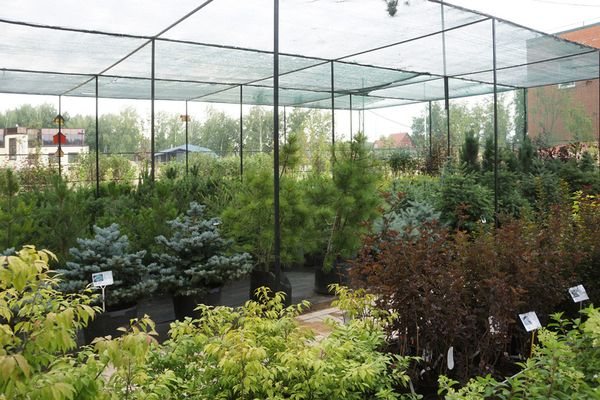

It is highly recommended to water the plant bought from the nursery abundantly
You can dip the root ball into the water for a while until air bubbles stop appearing from the water.
When buying, check the agrotechnical characteristics and check the viability of the bush: its branches should be elastic, healthy and strong. Sick and weak seedling it will not be possible to leave.
Mulching and feeding
For mulching the bushes, crushed pine bark, fallen needles, steamed sawdust, small expanded clay, peat or tree foliage (except for chestnut and maple trees) are used.
Mulching retains moisture in the ground, prevents weeds from growing, protects surface roots from overheating in summer and from freezing in winter. When mulching, the root collar should be free.
Without feeding, there will be no abundant flowering, and for the normal growth of azaleas need additional food... There should be several top dressing during the summer:
- In the spring, add a solution of mullein (humus) in a ratio of 1:10.
- At the time of bud formation, a second mullein feeding is carried out with the addition of phosphorus-potassium fertilizer.
- When the last buds fall off, a third feeding is carried out with phosphorus and potassium in a ratio of 1: 2.
- Top dressing is applied at a distance of 0.2-0.3 m from the center of the bush.
Rosewood is a graceful garden decoration
If you choose the right type of rosewood, follow all the rules of care exactly, it will become the best decoration of the garden and the pride of the owners... There are many reasons why you should plant a plant in your garden.
- Garden azalea varieties differ in color (they can be red, yellow, white, purple; multicolor and monochromatic). Combining different varieties with each other and with other plantings, you can create interesting landscape compositions that will become the highlight of the garden.
- By creating alpine slide, you should definitely add azalea to the composition. The shrub looks good next to pebbles, stones, cones, gravel, along streams, crushed bark. He will bring bright colors to the landscape and revive it.
- Can be constructed multicolor flower bedscombining different plants (including garden rhododendron). Multi-tiered plantings will delight the eye for many years.
- The garden will be decorated with a hedge of tall varieties of azaleas or a border of varieties, the height of which reaches 0.5 m.
- there is several options for growing garden rhododendron... Having chosen the right variety, it can be cultivated as an annual, perennial or biennial.
- Garden azalea pleases almost all summer a lush cloud of delicate inflorescences... Its subtle scent is pleasant.
- Attracts variety of varieties and types of shrubs... They differ among themselves not only in color, but also in terms of flowering, endurance. The height of some varieties is almost 3 m, others rise 0.3 m above the ground.Flowering may continue from 20-70 days.
- The rose tree will delight the family for a long time... It is believed that with good care, it can live for about 100 years.
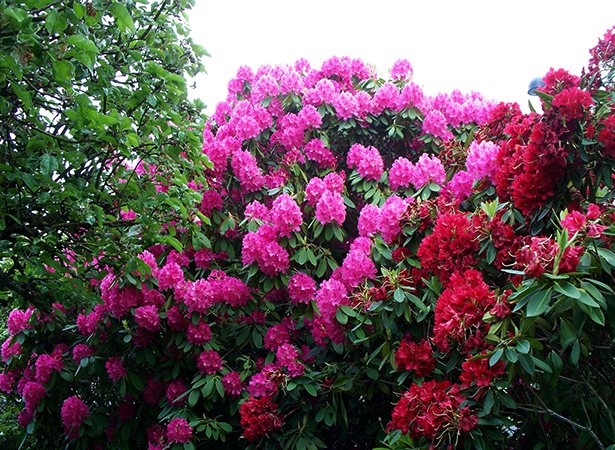

Step-by-step instructions on how to care for the garden
Novice gardeners doubt whether it is worth getting involved with growing rhododendron in the garden, fearing the difficulties of care. In fact, this plant is not particularly picky. Next, we will tell you in detail how to grow a rhododendron in a garden.
Seat selection
When choosing a suitable location for a garden rhododendron, it is important that it is as sheltered as possible from wind and direct sunlight. The rhododendron bushes grow here especially fatty fleshy, and the flowers are abundant. The shrub must be accessible for viewing. Only in this way will the decorative appearance of the culture during flowering be noticeable to others.
What should be the soil?
A special substrate is required to grow a plant., for the preparation of which, take the following components in equal proportions:
- heather land;
- peat;
- garden soil;
- rotted manure;
- needles.
Procedure
Landing operations are carried out as follows:
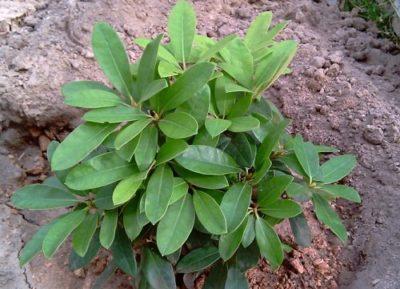

The completed well is filled with a substrate. In it, prepare a place for planting a bush. Place the plant itself strictly vertically.- Squeeze the ground near the root system of the bush. It is impossible for voids and "pockets" to form.
- If the groundwater level is high, then lay a special drainage layer at the bottom of the recess.
- After planting, mulch the top layer of soil using peat chips.
Temperature
On a note. In summer, the optimum temperature remains - 16-18 degrees Celsius. But if the plant is provided with full watering and air humidity, then 22 degrees are permissible.
Already from October, the temperature will drop to 5-8 degrees Celsius. Maintain it for 1.5 months, so that the kidneys begin to mature. When they swell, then increase the temperature again to 13-15 degrees.
Watering
The humidification of the garden rhododendron should be abundant, to a depth of 20-30 cm. To do this, use soft and acidified water. Water as the top layer of the earth dries up, avoiding drying out.
Top dressing
To feed the rhododendron, an aqueous solution of manure is used. Apply it before flowering. Granular superphosphate is used to form flower buds and extend flowering times. Scatter it on damp ground under the plants. Fertilizers with microelements are applied in the form of watering or spraying the leaves.
Pruning
Since the bushes form the correct shape, pruning should be minimal. But how to make a tree out of a bush, we will tell you. To do this, you should adhere to the following recommendations:
- Pruning is done in early spring, before sap flow begins.
- Remove all damaged and old branches during the pruning process. Shoots located in the lower part of the bush are also subject to removal. Leave only the top for proper crown formation.
- Treat all cut sites with garden pitch.
Transfer
If the rhododendron is grown at home, then it is recommended to transplant it every 2-3 years. To do this, it is necessary to use the transshipment method, and the container should be chosen one size larger.
The day before transplanting, thoroughly water the soil so that when you remove the bush from the old container, you do not injure the root system.
Attention! Immediately after transplanting, water the bush and set it in a slightly shaded place.
How to prepare for winter?
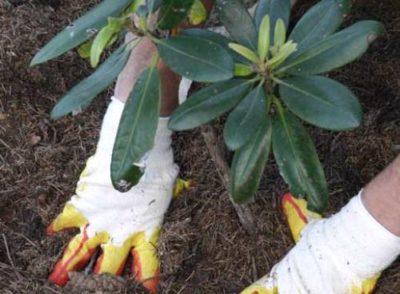

Consider what to do with a street plant in the fall. If the rhododendron hibernates outside, then the thickness of the mulch layer will have to be increased in order to protect the roots from freezing. In late autumn, the plant needs abundant watering. If you use rhododendrons, which do not winter well in the Russian climate, then there are two options: cover them with non-woven material (that is, make a winter house) or transfer them to an apartment.
How to keep a rhododendron in the winter in an apartment, in a pot? To begin with, you have to prepare a container and nutrient composition for home planting of rhododendron in the winter. After transplanting, the plant for the winter can be placed on an insulated balcony or loggia at home.
How to prepare a rhododendron for winter is described here.
The healing properties of some varieties
Garden rhododendron is quite a useful plant. It is very valuable for human health. In medicine, the following types are in great demand:
- rhododendrons of Adams;
- daurian;
- golden;
- yellow;
- Caucasian.
These plants are indispensable in the treatment of:
- heart disease;
- vessels;
- rheumatism;
- epilepsy;
- colds;
- vegetative neuroses.
Prevention of various problems
- Leaves darkened, began to fall off - watering should be adjusted.
- If the leaves turn yellow, the Nap Hill azalea needs fertilizing with nitrogen, magnesium and iron.
- The process of photosynthesis is disrupted, the leaves become pale - fertilizing with complex fertilizers is imperative.
- In summer, the leaves wrinkled and spots appeared on them - you need to increase the humidity of the air, add spraying.
Breeding the Nap Hill azalea requires effort and some knowledge of caring for exotics. Putting them into practice, you can expect a gorgeous flowering.
If you find an error, please select a piece of text and press Ctrl + Enter.
Detailed description
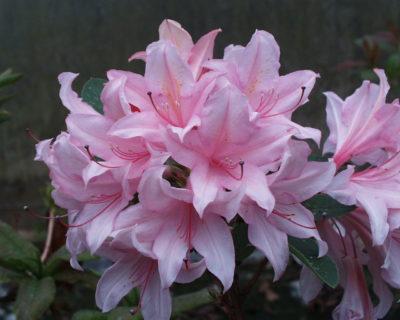

Azalea Nap Hill is a hybrid deciduous azalea. The shrub grows up to 1.5 - 2 m in height and 1.75 in width. The sub-varieties of this hybrid have different shades of flowers - red, orange, pink, apricot, white - pink, etc. The flowers are medium in size, fragrant, collected in inflorescences of 8 - 12 flowers.
Fruits are brown, small, ripen in autumn, in October, collected in capsules - cylinders. Leaves are oblong, lanceolate or elliptical in structure, green, change color, turn yellow or orange-red in autumn.
The hybrid is quite frost-resistant, it can withstand temperature drops of up to 25 - 30 ° C. We talked about frost-resistant rhododendrons in this article.
Subsorts and their photos
Below you can see a photo of flowers on a bush of street rhododendron, in particular, see bushes of the following types and varieties of garden plants:
Daursky
This is an elite variety of rhododendron. The height of the bush is 2-3 m. Differs in abundant flowering. In the warm season, re-flowering is possible.
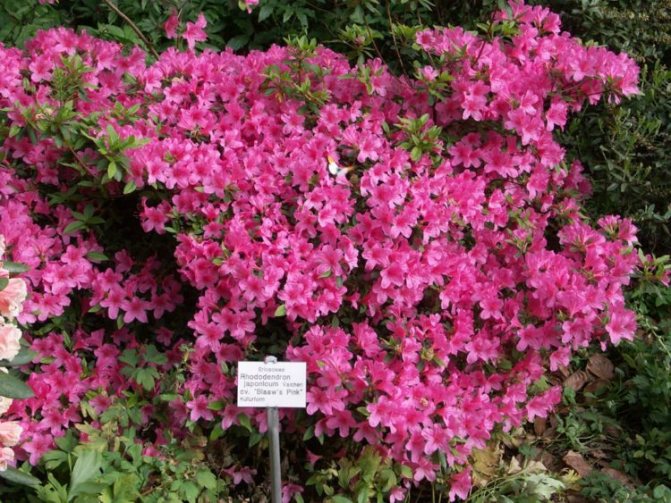

Adams
This guest came from the east. It has fleshy and beautiful leaves and delicate pink flowers. The height of the bush is 1.5 m.
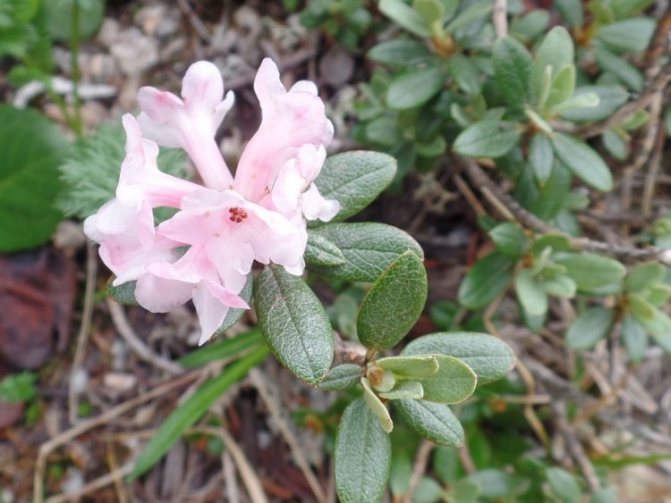

Caucasian
This bush is of short stature, thanks to which it spreads along the ground. Its inflorescences are pale yellow or cream.
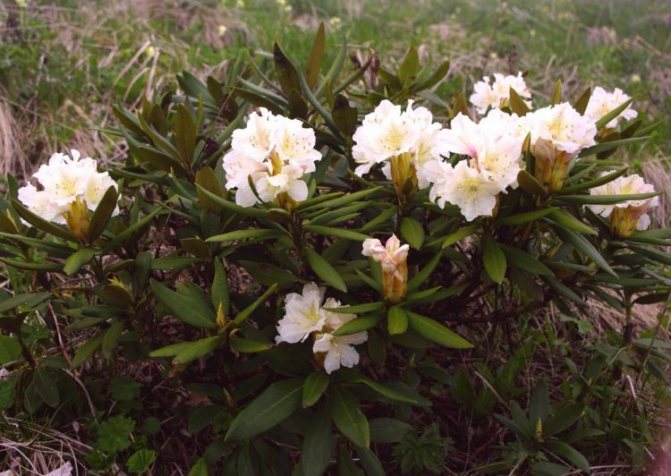

Japanese
It is a deciduous variety. It has fleshy and large leaves that turn red with the onset of autumn. It has lobster buds.


Pruning
Pruning bushes is carried out in three stages:
- In the spring, they do sanitary pruning, cutting out diseased and dry shoots. The rest of the shoots do not touch - flower buds have been laid on them since autumn.
- During flowering regularly remove wilted flowers.
- After the last buds wither, formative pruning is carried out - remove dry peduncles, shorten shoots that are too long, cut out branches that strongly thicken the bush.
The remaining shoots are shortened by no more than 1/3 of the total length - the next year the azalea will branch out and take the form of a lush and abundantly flowering plant.
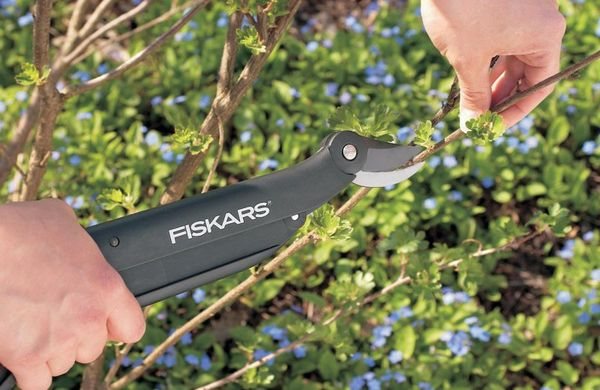

When pruning a bush, keep in mind that pruning types depend on the season
With any pruning, the places of the cuts are covered with garden varnish or any paint based on drying oil. Work is carried out in protective gloves to avoid skin irritation - the sap of the plant is poisonous.
Additional tips and tricks
In order for the culture to grow normally and please with abundant and lush flowering, it must be properly looked after:
- choose the right place for planting - azalea prefers diffused lighting;
- ensure the optimal composition of the soil - it must have sufficient acidity;
- water the crop in a timely manner;
- apply fertilizers taking into account the seasonal factor;
- timely trim the plant;
- carry out preventive and therapeutic treatments for diseases and pests;
- adhere to the rules when transplanting a culture.
Garden azalea is considered a popular plant that is grown by many growers. To be successful in this area, the culture needs to be cared for in a holistic manner. It should include timely watering, fertilization, pruning. Protection of the culture from diseases and parasites is of no small importance.
Deciphering the icons on the clothes Test for cleanliness in your home Laundry weight calculator for washing Ask an expert
Share link:
Popular species and varieties
Among the types of high decorativeness, large-flowered and Japanese azaleas are popular.
Deciduous (large-flowered) varieties are characterized by high growth and large flowers of various shapes. The flowering period is late May and early June.The most popular winter-hardy varieties: Chanel, Freya, Klondike, Tunis, Sonya, Starus, golden Golden Lights and Golden Sunset, one of the most beautiful varieties of late flowering bright orange Gibraltar ".


Variety "Gibraltar"
Japanese azaleas are characterized by slow growth and a more compact bush not exceeding 60-100 cm. There are dwarf varieties not exceeding 30 cm in height. The shrub grows more in breadth than upward, so it can be used as a ground cover. Flowers delight gardeners with all shades of pink, lilac and purple. Leaves usually fall off in the winter, but not in all varieties. Several popular varietal forms: “George Arendés”, “Kermezina”, “Rosinetta”, “Silvester”, “Rubinstern”, “Marushka”, “Blue Danube”.
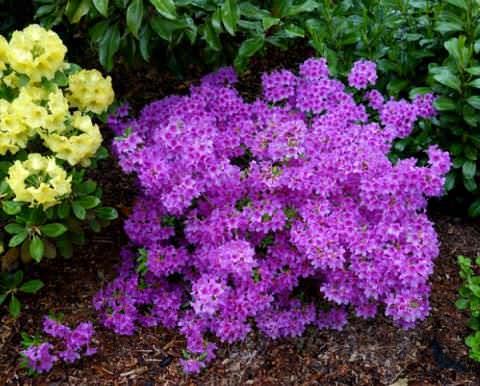

Variety "Blue Danube"
The duration of flowering, depending on the species and variety, varies from 3 weeks to 2 months, and the first time the culture blooms for 3 years.
Top dressing
Azalea in the garden is demanding not only for watering, but also for various kinds of feeding.
Top dressing consists not only in applying fertilizers during the growth of the bush, but also in an optimally selected and cultivated land plot.
You can "fill" the site with a mixture of humus, sand, peat, coniferous, turf, leaf lands. All components should be taken in equal proportions.
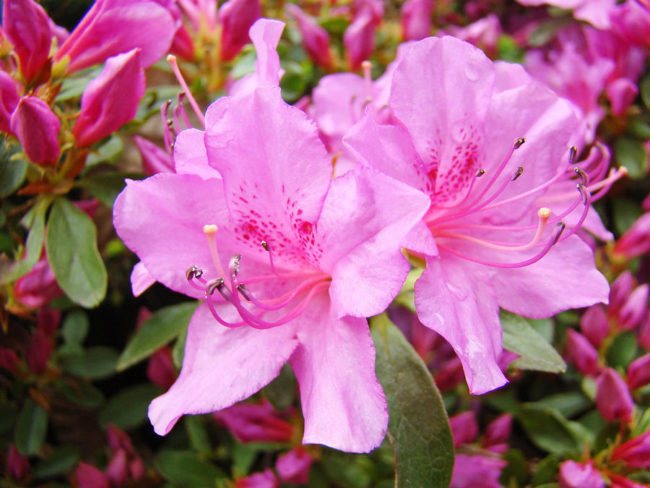

After the planting of the garden azalea is made, after a while, cow manure is introduced under the bush in the form of a solution. This is usually done in the spring, but it can also be done in the fall. Remember that manure should be cow manure, not pork or horse manure! Feed the flower a second time just before flowering. The solution consists of mullein, potash and phosphorus fertilizers. After the end of the flowering period, the shrub can be fed with force-potassium substances in a ratio of one to two.
Adult garden plants should be fed with long-lasting complex fertilizers in early spring.
In this case, fertilizers are laid out at a distance of about twenty centimeters from the bush. It is undesirable to use granular imported long-acting fertilizers, because their effect is calculated up to six warm months. In this regard, feeding them under our conditions can lead to the formation of shoots that do not have time to ripen.
It is also worth remembering that wood ash reduces the acidity of the soil and is not suitable as a top dressing. It is not recommended to fertilize with mixtures containing chlorine and lime. It is necessary to strictly observe the sequence of the composition of the dressings and the period of their introduction. By violating this order, you can get an undesirable effect, namely: the inflorescences are formed ahead of time, dry out or begin to crumble. In moments of caring for your "favorites" do not overdo it with feeding!
How cold-resistant azalea differs from room
As mentioned at the very beginning of the article, azaleas can be grown not only outdoors. The compact varieties make excellent representatives of the window flora.
What is the difference between garden and indoor varieties? Potted crops have compact densely leafy bushes that do not exceed a height of half a meter, usually 25-30 cm. They can be larger (up to 1 m) if they are formed in the form of a standard tree, because the birthplace of exotic plants is Japan, where they are sensitive to the ancient art of bonsai ... Window flora is sold in garden centers all year round. Buds or flowers appear on it at the end of winter.
Seedlings of frost-resistant garden species are sold mainly in early spring or autumn. The height of a seedling at the age of 3 years is about 30-50 cm, its crown is much less common. If the purchase is made in the spring, then there should be no leaves on the bush.
Know! When visiting the garden center, you can find indoor rhododendron varieties in the pot crops section, and garden varieties in the outdoor crops section.
Winter preparation and spring care
The buds of the next year are laid in the fall.Therefore, it is important to preserve the plant during the winter and help it survive the frosts.
Despite the relatively good winter hardiness of many varieties, it is more reliable to cover the shrub for the winter in order to ensure that flower buds, young branches and superficial roots are kept healthy:
- After water-charging irrigation, the ground under the bushes is mulched 5-10 cm thick.Under tall azaleas, the mulch layer can be increased to 30 cm.
- The branches of deciduous varieties are gently bent to the ground and fixed with wire... A multilayer shelter is made of corrugated cardboard, covering materials and spruce branches.
When organizing winter protection, polyethylene and other airtight materials are not used, otherwise the buds and shoots will mate and rot.
- For evergreen varieties, a frame is preliminarily made, which is installed before the ground freezes, the covering material is pulled onto the frame only with the onset of stable cold weather.
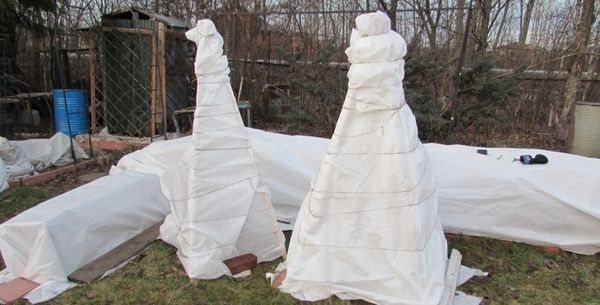

Do not use materials that are not breathable, otherwise the bush will rot
The frame is insulated with durable materials or roofing felt so that a distance of 20-25 cm remains between the walls of the shelter and the bush. To drain moisture under the structure lay flexible hose, the other end of which is taken out.
With the onset of the first spring days, you should not rush to open the azalea bushes, you need to wait for the complete melting of the snow cover on the site. Plants that have become unaccustomed to sunlight over the winter should be gradually accustomed to the spring rays, opening them briefly in the morning and gradually increasing the time.
Plants tolerate winter differently and must be cooked accordingly. For example, there is a procedure for how to prepare gloxinia for wintering and a dormant period.
Azalea is a demanding outdoor plant. She needs to create certain conditions under which she will feel good. In response, the shrub will thank you with a huge number of flowers that will delight you for a long time. Planting several varieties of azalea with different flowering times at the same time allows you to enjoy a riot of colors throughout the summer.
Azalea (Azalea) is one of the most impressive flowering shrubs that turn the garden into a bright colorful show in spring and early summer.
From year to year, the culture is becoming more and more popular, and breeders are creating more and more unusual varieties. Today, there are more than a hundred hybrids and varietal forms of garden azalea, the care of which in the open ground is not as difficult as many believe.
Use in landscape design
Quite often, azalea is planted in the garden for decorative purposes. It is recommended to combine it with perennials. Such bushes will help set off this beautiful culture. Hostas and ferns can be great additions to azaleas.
If you want to combine the plant with flowering bushes, it is best to give preference to the white options. They will be in perfect harmony with large and bright azalea flowers. A no less successful option would be a combination of a plant with green conifers.


Growing rules
Choosing garden soil and planting azaleas
Cultivation of azaleas requires the creation of appropriate conditions and an important factor necessary for successful cultivation is, first of all, a substrate that ensures the correct development of the shrub and the intensity of flowering. The plant belongs to acidophilic crops, which require an increased level of soil acidity, approximately 3.5 - 4.5 pH.
Before planting azaleas in garden soil, you need to properly prepare it. After digging a hole to a depth of 40-50 cm, the extracted soil is mixed with components that increase acidity - peat and compost based on needles or crushed bark of coniferous trees, taken in equal proportions.
Varietal variety
Breeders have developed a large number of azalea varieties. They differ in size, flower color, leaf shape.
Chanel
This hybrid is considered large-flowered. It is characterized by dark green leaves covered with fluff.
Freya
This bush is characterized by compact size. The flowers are golden pink in color and bloom in June.
Klondike
The buds of this plant are covered with orange spots. The plant exudes a pleasant sweet aroma.
Tunisia
This variety is characterized by large flowers that resemble bells. They are distinguished by an orange-red tint.
See also
Rules for planting and caring for different types of lavender in the open field


Sonya
It is a beautiful plant with large flowers that appear in June.
Starus
It is a deciduous crop characterized by large flowers. The bushes are very impressive in size.
Golden lights
This hybrid is characterized by abundant flowering. Flowers have a yellow-orange tint and form inflorescences of 10 pieces.
Gibraltar
It is a very beautiful plant that has rich bright orange flowers and elliptical leaves.
Golden sunset
This variety is characterized by spherical inflorescences that include large bright yellow flowers.


George Arendés
This is a very beautiful plant that belongs to the variety of Japanese azaleas. It is very popular with flower growers.
Kermezin
This variety is characterized by simple, bell-shaped flowers. They are ruby pink in color.
Rosinette
This decorative culture is densely covered with pink flowers. The plant is characterized by compact size.
Silvester
It is an evergreen shrub with a dense crown and silvery pink flowers. The plant does not exceed 0.5-1 meters in height.


Rubinstern
This plant is distinguished by its lush flowering. It is characterized by glossy dark green leaves and ruby red flowers.
Maruška
This plant develops rather slowly and does not exceed 50 centimeters in height. The culture begins to bloom in May.
Blue danube
It is a dwarf variety that spreads along the ground. The bush is covered with bright purple flowers.
Esprinsessin
It is an evergreen crop that has beautiful leaves and white double flowers.
Adonis
This crop is considered evergreen, but it partially sheds its leaves. The flowers are medium in size and white in color.


Geisha Orange
This plant is characterized by beautiful orange flowers 3-4 centimeters in size. They appear in May and June.
Description
Garden azalea can be both evergreen and deciduous, as well as undersized (no more than sixty centimeters) and tall (about three meters). Depending on the species, there are elliptical, round, carved leaves covered with hairs. Inflorescences reach a diameter of 6 - 10 centimeters. The number of their shades is striking: starting with white, bright red and ending with deep purple. The petals are monochromatic, multi-colored, double, flat or funnel-like. Usually in the open field, azaleas delight with the beauty of inflorescences for two months.
Rhododendrons are also distinguished by the flowering period of the variety:
- early (blooming from May to June);
- medium (blooming from January to March);
- late (flowering period from March to April).
Growing conditions
The decorativeness of a rose tree will directly depend on the space allocated to it in the garden and the care provided. We will talk about this in the relevant sections of the article.
But it is important, when choosing a place for planting, to build on the biological characteristics of the plant. The structure of the root system and the habit (appearance) of the shrub makes it possible to plant it far from everywhere. The roots of the exotic are fibrous, lie in close proximity to the soil and tend to grow in breadth in order to increase the feeding area. This feature does not allow planting exotics near neighbors with the same type of root system - linden, elm, maple, birch, willow.When planted next to these trees, a struggle for nutrients and territory is inevitable.
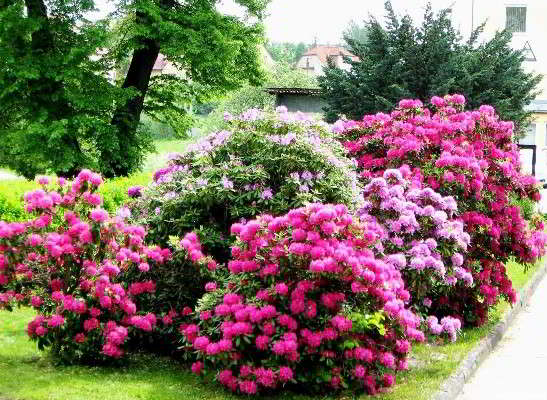

In the wild, the Asian woman grows under the canopy of other trees, so such a neighborhood is preferable for her. Feel free to plant exotics in the shade of oak, pine, larch, fruit bushes. Their root system is arranged differently - the central root goes deeper in order to get water for itself. Be sure to step back from the tree trunk circle at least half of the projection of its crown.
Advice! If it is not possible to plant an Asian guest away from the described unfavorable neighbors, experienced gardeners recommend isolating the food area by laying plastic wrap in the soil.
Preparing azaleas for winter conditions
Azalea blooming next season depends on proper wintering. They begin to prepare shrubs for the cold in mid-summer - they reduce the number of waterings and stop feeding. In the fall, the plant is well watered. The root system is insulated with mulch (10-30 cm).
Deciduous bushes are less likely to freeze. It is enough to bend the branches to the ground, fix them with staples and cover them with coniferous branches and covering material.
Evergreen species require an air-dry shelter. A special frame is constructed from a metal mesh. Covering material is pulled over it in two layers.


The shelter is removed when the frost stops, first for a few hours on cloudy days. Then the time is increased. The main thing is not to burn the plant with the first rays of the sun.
Care after planting, pruning rules
Taking care of an Asian guest is not too difficult. When handled with care, the luxurious exot will give you a long and bright bloom. Correct care is based on regular abundant irrigation, periodic spraying of foliage. Water for irrigation should be soft, settled, warm. Use rainwater or pond water. If this is not available, soften it by adding a little peat a day before watering. The exotic is very hygrophilous, but it will not tolerate the cultivation of the swamp.
Watering must be carried out in small portions, as soon as the top layer of the earth dries up. It is especially important to maintain irrigation during the budding and flowering period. It is useful to acidify the soil monthly when watering, using the juice of 5 lemons, dissolved in 5 liters of water. An adult bush will need 2.5 liters of such liquid, and a young one was flogged with 1.5 liters.
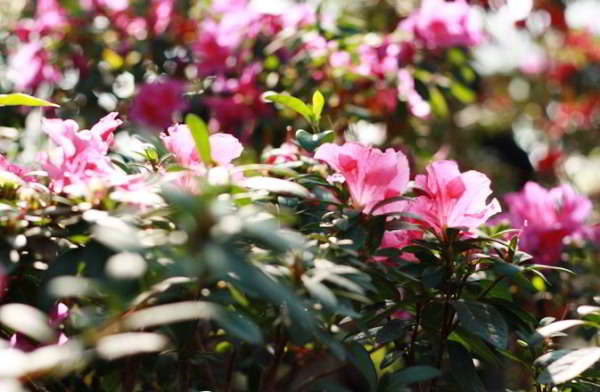

By the end of August, gradually reduce irrigation to slow down growth and speed up maturation of the wood. Watering in the fall is carried out only in the absence of natural precipitation for a long time.
On a note! The lack of moisture in the soil can be judged by the change in foliage turgor. Loss of gloss and drooping of the foliage is a signal for urgent watering.
To prevent the plant from suffering from rapid evaporation of moisture and overheating of the roots, be sure to mulch the trunks. Mulch must be refilled periodically. Loosening after watering is unacceptable, because the most delicate network of roots lies in close proximity to the surface of the earth. Because of this, you cannot use a hoe for weeding, remove the weeds by hand.
Azalea will bloom more magnificently with timely fertilization, but it cannot be overfeeded either. Nitrogen in the form of mullein is applied only in early spring. It will help you wake up from sleep and start building up green mass. In further fertilizing, this microelement should not be, otherwise you may not wait for flowering, but the bush will become much more magnificent. Apply potash fertilizers such as potassium nitrate before flowering. Feed the shrub for the last time in mid-July using phosphorus complexes.
Remember! It is unacceptable to add wood ash - it will shift the pH level to the alkaline side, which will cause chlorosis of the foliage. Lime formulations and fertilizers with chlorine will lead to the death of the plant.
A feature of the rhododendron is that pruning is not an obligatory measure, because the tree is able to independently form the correct crown. If there is no need to thin out the crown or slightly reduce its splendor, then the haircut is carried out in early spring. It serves to reorganize the bush.
At the same time, all damaged and frozen branches are removed, a sick, weak growth is cut out. Sections thicker than 2 cm are treated with linseed oil, garden var. Rejuvenation is carried out in two stages, cutting out half of the branches at a height of 40 cm. The second part is removed in the next season. Do not forget to be careful when cutting, because the sap of the plant is poisonous.
Since rhododendrons bloom on last year's shoots, formative pruning is carried out after flowering so as not to affect the flower buds. Remove wilted inflorescences and adjust the crown without affecting the young growth.
Exot is susceptible to fungal diseases, rot, spots, rust. They arise with improper agricultural technology and sharp fluctuations in the temperature background. Spring treatment with Bordeaux liquid will help protect the bush from the attack of fungi. If you find signs of disease, treat the bushes with a fungicide solution.
Important! Chlorosis of foliage is manifested by a weakening of the color of the plates. Adjust the acidity of the substrate by adding peat or watering with lemon water.
If pests are detected - aphids, thrips, spider mites, mealybugs, spray the bushes with a systemic insecticide.
Where does the garden bush azalea come from?
In addition to white, pink, yellow, purple, red or orange color, there are varieties with multi-colored buds, which makes the plants even more decorative. Lush flowering subject to the rules of agricultural technology lasts from 3 to 10 weeks.
The basis of hybrid varieties that can withstand the moderate winters of the Central Russian zone in the open field is Japanese, which is considered a national plant in its homeland. The ancestors of the greenhouse varieties are the heat-loving Indian azaleas.
How to plant correctly
For a culture to flourish, it needs quality care. Correct planting is of no small importance.
Timing recommendations
It is recommended to plant azalea in the ground in early spring - at the end of March or mid-April. It is also permissible to carry out planting work in September.
How to choose and prepare planting material
It is worth buying bushes in the spring - this will help assess the quality of the planting material. It is recommended to buy azalea in a bulk container.
The substrate must be moist. It is important that the seedling is strong.
Site and soil requirements
It is recommended to plant an azalea in a shaded place, since the culture does not tolerate exposure to direct sunlight. At the same time, in strong shading, the plant will not bloom. When choosing a soil, high acidity should be preferred.
Azalea should not be planted in loam or calcareous soil.
Landing scheme
To carry out planting work, it is worth performing the following actions:
- dig a hole 50 centimeters deep, 70-80 centimeters wide;
- lay expanded clay and sand drainage on the bottom;
- mix the soil from the pit with sand, peat and humus;
- remove the plant from the container with a clod of earth;
- pour prepared soil into the center and install azalea;
- sprinkle the plant with soil so that the root collar remains on the surface;
- compact the soil and water;
- cover with a mulch layer.
Azalea varieties
Azaleas have two main varieties - Japanese evergreen and deciduous.
The most popular evergreen Japanese azaleas are:
- Adonis. The bush has strong shoots and a rounded crown. The flowers are snow-white. It is necessary to choose the right place for planting, does not tolerate the bright sun and drafts.
- Drapa.It is a newly developed late-blooming variety with charming lilac-pink flowers that delight the eye for three weeks.
- Melina. Dwarf variety, no higher than 30 cm in height and 50-60 cm in width. It blooms with crimson-pink flowers, collected in dense inflorescences. Prefers moisture and coolness.
- Konigstein. Bushes are low and slow growing, no more than 0.5 m in height. It blooms from the end of May with purple-violet flowers with dark veins.
- Blauves Pink. A dwarf shrub that grows up to 80 cm in height. It blooms in May-June with salmon-pink flowers. Sometimes sheds leaves partially.
- Weeks Scarlet. A dwarf variety, no higher than 60 cm, can be grown in pots at home. Blooms in May-June with red-orange flowers.
- Geisha Orange. The bush is of medium height, about 1 m, fast growth and high winter hardiness. The flowers are of an unusually beautiful bright orange color.
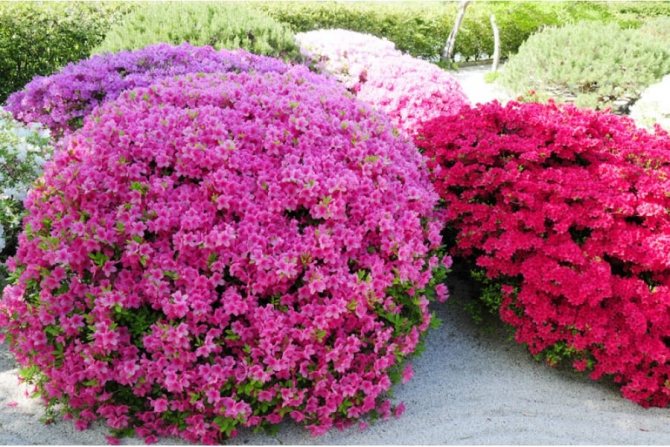

Among the deciduous azaleas, the following varieties are best known:
- Golden Lights. A frost-resistant bush 1.5 m high, with very beautiful golden yellow flowers, blooms in May-June. Prefers abundant watering and acidified, humus-rich soils.
- Koichiro Wada. Possesses high frost resistance, reaches a height of 1.4 m, has bowl-shaped flowers, which, in the process of development, turn from pink to snow-white.
- Satan. Bushes are tall, 1.8 m, blooms in May-June with scarlet simple flowers. Well-lit areas with loose soil and good drainage are preferred.
- Czardas. It begins to bloom in May, flowers are double, of an unusual yellow-cream shade. Prefers areas brightly lit by the sun.
- Slavka. Bushes 1-1.4 m high, double flowers, snow-white, spherical crown.


Possible growing problems
When growing azaleas, there is a risk of various problems. To cope with them, you need to establish the cause.
Powdery mildew
The cause of the disease is considered to be a violation of air circulation and sharp temperature fluctuations. In this case, the damaged fragments are covered with plaque.
Fungicides will help to cope with the problem.
Late blight
This disease affects the stem and leaves of the crop, which leads to its rotting. The problem occurs with high humidity and temperature. Fitoverm will help to cope with the disease.
See also
Growing and caring for Chinese lemongrass, planting secrets


Gray rot
It is a fungal infection that infects leaves, stems, and buds. At the same time, they become covered with brown spots. Soap solution will help to cope with the disease.
Rust
With this disease, spots appear on the plant. Over time, the leaves fall off. Bordeaux liquid will help to cope with the disease.
Chlorosis
With this disease, the leaves change their color - they become lighter. Iron chelate will help to cope with the disease.
Lack of flowering
The reasons for the lack of flowers are considered to be a lack of scattered light, insufficient watering, improper soil composition, and a lack of fertilizers.


Lack of buds
The absence or fall of azalea buds is due to temperature fluctuations or changes in weather conditions. Also, plant transplantation or a lack of fluid leads to problems.
Aphid
These small insects slow down crop development and spread viruses. Actellik and Karbofos will help to cope with them.
Black thrips
These pests affect the foliage of the azalea. As a result, it acquires a yellow tint and falls off. Karbofos will help to cope with pests.
Spider mite
These pests lead to the appearance of cobwebs on the bushes. Actellik will help to cope with them.


Mealybug
These parasites infect all fragments of the culture and create conditions for the development of a sooty fungus. Actellik will help to eliminate pests.
Whitefly
This butterfly absorbs plant sap. As a result, they wither and die. Aktara or a soap solution will help to cope with pests.
Watering, weeding and spraying
Watering the azalea should be abundant throughout the summer season. A slightly dried soil surface is a signal for the next moisture. Water the plant with rain or settled water, adding citric acid to the irrigation water once a month (1 tsp for 2 liters of water) - it increases the acidity of the soil.
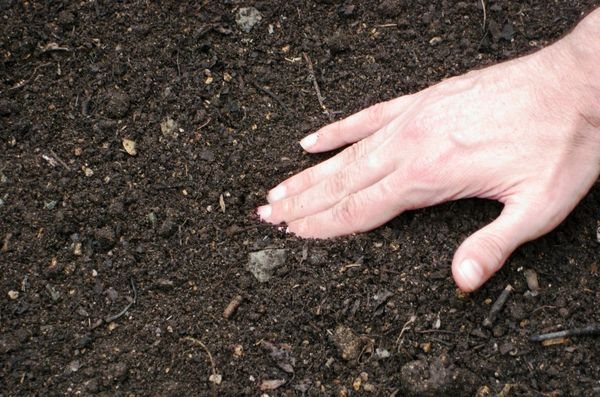

As with any plant, it is highly recommended to consider the seasonality when watering the bush.
With the beginning of autumn, watering is reduced so as not to provoke the growth of new shoots, which will not have time to mature and freeze before winter. Before the beginning of winter, the plant is watered abundantly - water-charging watering will allow to endure frosts with minimal losses.
Besides watering, azalea loves sprinkling - humid air is favorable for the decorativeness of the plant and is a prophylactic agent against insect pests. However, during flowering, this procedure must be abandoned, otherwise spots will form on the flowers, spoiling the appearance of the plant.
Do not forget about weeding - during the entire growing season, you need to weed the area several times. Only this must be done carefully so as not to damage the surface roots of the azalea.
History of origin
Azalea Nap Hill is a hybrid variety, bred in the 19th century in the English nursery Knap Hill Nursery, founded by the scientist - breeder Anthony Warter. The Nap Hill series is based on the American and Japanese species of azaleas.
Reference! In the 20th century, Baron Rothschild continued to work on improving the hybrid varieties of this species. On the Exbury estate, in England, a garden of hybrid azaleas has been preserved to this day.

